
- SAP PS Tutorial
- SAP PS - Home
- SAP PS - Overview
- Integration with ERP Modules
- Organization Structure Elements
- SAP PS - Currencies
- SAP PS - What is a Project?
- SAP PS - Defining Special Characters
- SAP PS - Status Profile
- SAP PS - Selection Profile
- SAP PS - Project Profile
- SAP PS - Settlement Profile
- SAP PS - Network Profile
- SAP PS - Network Type
- Person Responsible for Work Center
- Maintain Activity Control Key
- SAP PS - Access Control List
- SAP PS - Cost Component
- SAP PS - Execution Service Profile
- SAP PS - Budget Management
- Number Ranges for Budgeting
- SAP PS - Revenues and Earnings
- SAP PS - Dates
- WBS Scheduling Parameters
- SAP PS - Material
- SAP PS - Versions
- SAP PS - Project Information System
- SAP PS - Consultant Responsibilities
- SAP PS - Useful Resources
- SAP PS - Questions & Answers
- SAP PS - Quick Guide
- SAP PS - Useful Resources
- SAP PS - Discussion
Organization Structure and Elements
When a project is initiated, it starts with the definition and classification of the project structure, which is required to align it with the existing enterprise structure in an organization.
Project System has no organizational structures of its own and we have to incorporate the structure to enterprise structure by assigning organization elements in different ERP R/3 modules. These organization elements allow Project system to maintain and get the data correctly.
An Organization structure consists of various elements that have to be created as part of structuring of project. Following are the organization elements −
Company Code
In SAP FI, a company can comprise of multiple codes, however it acts as a single unit for which financial statements are available. Company code is smallest unit in an organization for which financial statements (profit-loss statement, etc.) can be generated.
To create, edit and delete a company code, follow the steps given below −
Step 1 − Expand Enterprise Structure → Definition → Financial Accounting → Edit, Copy, Delete, check company code.
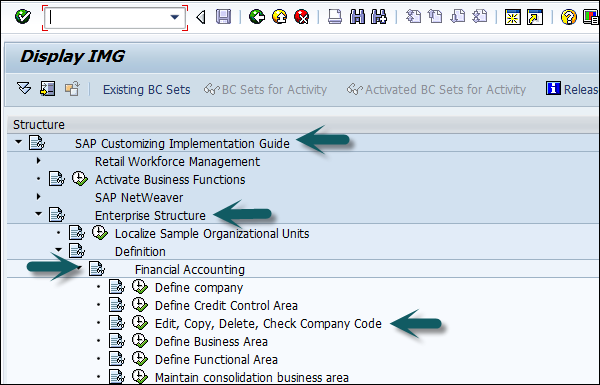
Step 2 − A new window will open. You can create new company code by selecting both the options.
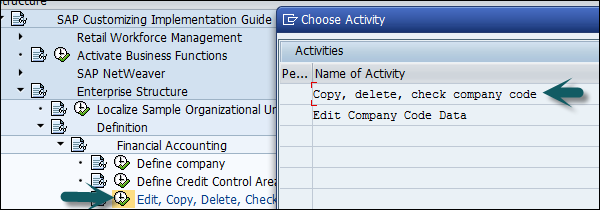
The option Copy, delete, and check company code allows you to copy all configuration and tables automatically.
Step 3 − If you select Edit company code, you will get the following window

Step 4 − Click New Entries and update the code details.
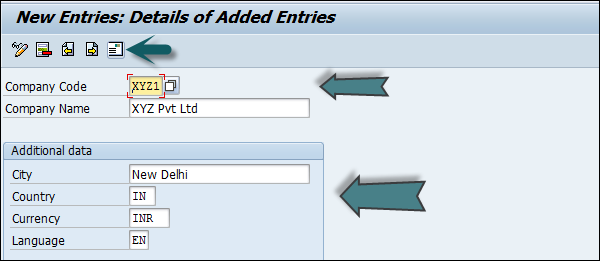
Step 5 − You can click the Address button and update the fields as shown below. Once Address field is updated, click the Save button.
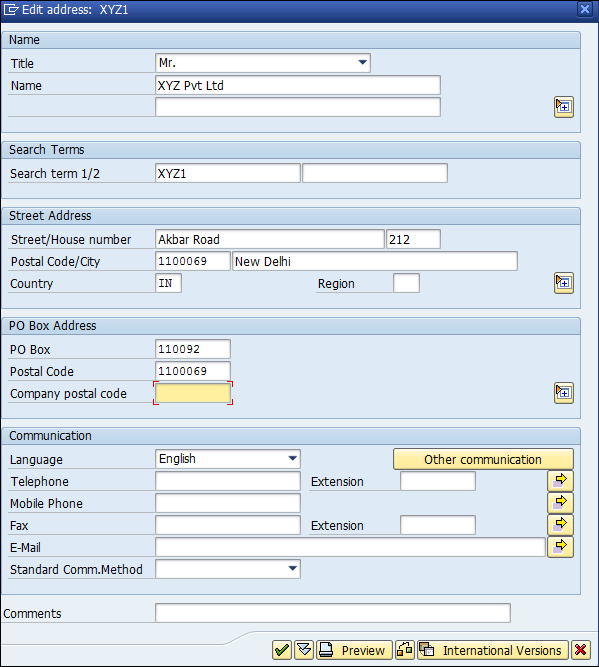
Creating a Business Area
Business Areas are used to differentiate transactions that comes from different line of business in a company.
Example
There is a big company XYZ, which runs multiple business. Let us say it has three different domains like manufacturing, marketing and sales.
Now you have two options −
- First is to create different company codes
- The other option is to create each of these business lines into business areas.
Benefits of using Business Areas in this case −
You can use these business areas if other the company codes require the same areas.
It is easy to configure if you use Business Area because you just need to attach to the company code and the other details in business area will get attach itself.
By using Business areas in controlling, you can create profit and loss statements, balance sheets, etc. for business areas. Therefore, this is used for management accounting in few companies.
Note − Business areas are used in Controlling as compared to Finance Accounting.
Create new Business Area in SAP FI
Step 1 − Expand Enterprise Structure as Definition → Financial Accounting → Define Business Area.
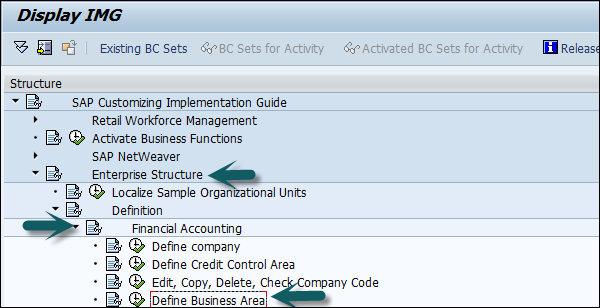
Step 2 − A new window will open. Click New Entries.

Step 3 − Enter the 4-digit Business Area code and save the configuration.
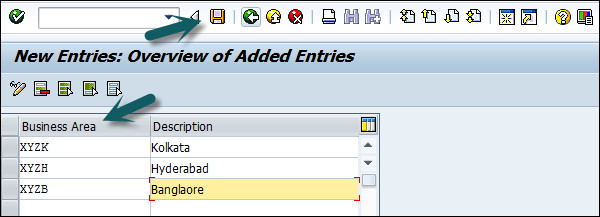
Creating a Controlling Area
Controlling Area in an organization is defined as an organizational structure and is cost accounting, Cost centers, profit centers are used to define the Controlling area.
Step 1 − To maintain a Controlling area, use T-Code: OKKP or go to Controlling → General Controlling → Maintain Controlling Area → Maintain Controlling Area.
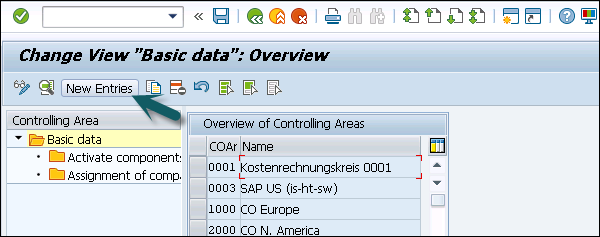
Step 2 − To create a Controlling area, click New Entries. Enter the following details
- Name of Controlling Area
- Company Code
- Currency settings
- Cost Center standard hierarchy
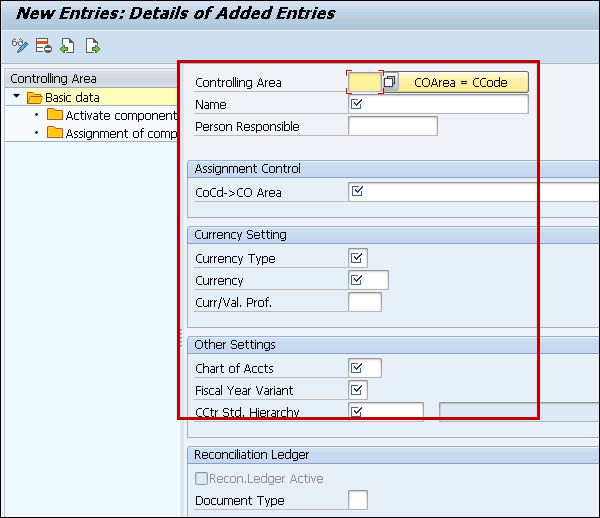
Defining Plant
Plant is an organizational unit within a company where activities take place. A plant will produce goods and makes goods available for the company.
The following steps will take you through the procedure of creating Plant −
Step 1 − Go to IMG → Enterprise Structure → Definition → Logistic General. Click the Define, Copy, Delete check plant icon or use T-Code: OX10.
Step 2 − Select Define Plant to create a new plant.
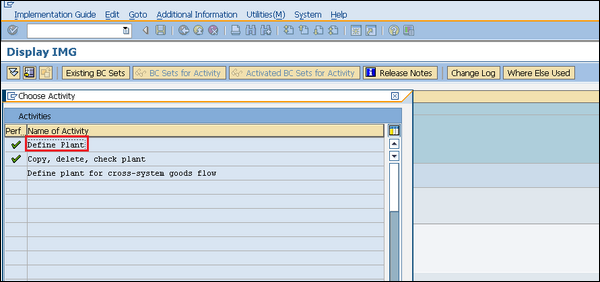
Step 3 − Click New Entries.
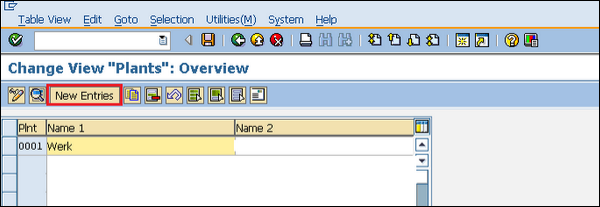
Step 4 − Fill in all necessary details like plant name, along with detailed information like Language, House no., city, country, region, postal code.
Step 5 − Click the save icon. A new plant will be created.

Creating a Storage Location
Storage location is an organizational unit, which actually differentiates between different material stocks in a Plant. Storage location is a place where stock is kept physically. Plant can be consisting of multiple storage location. All data is stored at storage location level for a particular storage location.
The following steps will take you through the procedure of creating Storage location −
Step 1 − To Create Storage Location, IMG → Enterprise Structure → Definition → Materials Management. Click the Maintain Storage Location option or use the T-Code: OX09
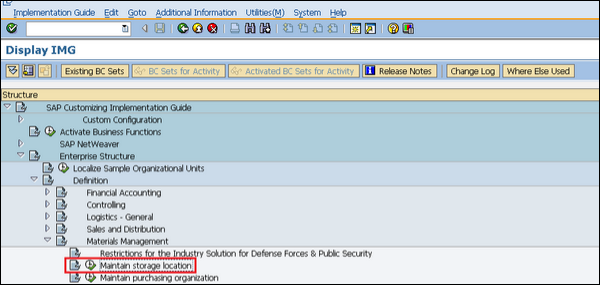
Step 2 − Enter the name of plant for which you want to create storage location.
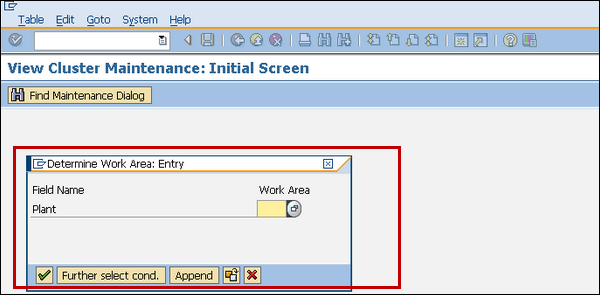
Step 3 − Click New Entries.
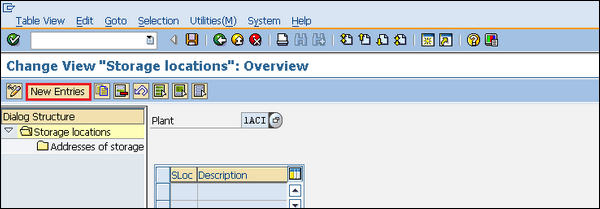
Enter the name of storage location along with the description of storage location.
Click the save icon after filling required information. A new Storage Location will be created.